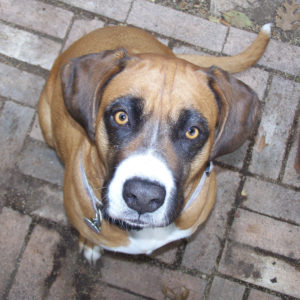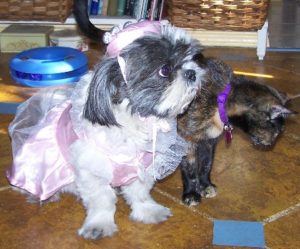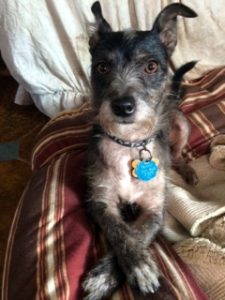
Calla-Puppy; the model for Dog
As a writer whose household contains dogs, cats and chickens, it has amused me ever since my first novel to include some of those pets as characters. In To Truckee’s Trail, my daughter’s boxer-mix, Calla was dressed up somewhat with a size and intelligence to play the part of Elisha Stephens’ companion on the overland trail; Dog. Yes, his dog was named Dog – the character was not terribly imaginative. Dog makes her first appearance in the second chapter:
John looked down; not very far down at that, at one of the largest dogs he had ever seen, a huge fawn-colored mastiff bitch with a dark face. She sat quietly at his feet, regarding him with intelligent golden eyes. “Dog,†said the smith quietly, and made a quick gesture with his fingers. The mastiff bitch nudged John again, as if reminding him to be on his best behavior then, because she would have an eye on him, and obediently trotted away to settle herself underneath the wagon. From there she still regarded John and her master with those unsettlingly intelligent golden eyes. She had a clownish white splotch on her nose and another at the end of her tail. All of her toes on each foot were white, as if she wore dainty gloves.
My daughter brought Calla home with her, when she finished her second hitch in the Marines in 2006. Calla and Dog, besides having the same appearance, were both excellent travelers. Calla loved riding in the car, even on long distances, and guarded the car as zealously as she guarded the house, hopping into the driver seat and growling at anyone who came just a little too close. Alas, even though she was a mixed-breed and presumably had some hybrid vigor to count on, she was a large dog, and those breeds in her makeup were prone to age rapidly – she only lived to the age of 12.

Spike – the original inspiration for Mouse
The second dog of ours to make it into my books was Spike the shih-tzu, who came to the household as a puppy, from a couple who thought they wanted a puppy, and then decided the puppy was too much trouble to housebreak and socialize. Spike had attitude to spare, which was why we called her Spike, and adorned her with a small black leather collar studded with silver spikes. Spike was bred to be a lapdog and constant companion, and by the time we adopted her, I was already largely working from home. Her natural place was the space underneath my chair, or within three or four feet of wherever I happened to be. She was also a very good traveler, insofar as long stretches in a car; we made several long-distance journeys to California from Texas and back. She was not so agreeable to having her home routine disrupted, though: she distinguished herself by surreptitiously piddling on every one of the area rugs in my parents’ house. Spike was the inspiration for Magda Becker’s Pekinese (or rather series of Pekinese dogs) in the Adelsverein Trilogy:
There were six puppies, lively squirming little balls of fur; four of them gold like their mother, one black, and one piebald white with brindle spots. That one seemed to be more sedate, not as excitable as the others. Magda put her fingers around the pup—it was heavier that it appeared, no fragile little handful of bones and fur. It looked at her with curious eyes, as she said, “This one, Irina.â€
“Very good,†Princess Cherkevsky nodded, regally. “That is a boy. Your son already brought a little collar and a bed and dish for you.â€
“You and he plotted behind my back,†Magda exclaimed. She sat back on her heels, with the puppy cradled in her lap. “I know he loves dogs, but this is not a dog, it is more like a mouse!†And thus did the pup receive its name.
Spike also developed chronic health problems peculiar to dogs whose popularity leads to inbreeding. She passed away rather suddenly at a relatively young age; we think she ate some grass which had recently been sprayed with a powerful insecticide, and died almost overnight, even before we could get her to the veterinarian.

The third of our dogs to appear in my fiction is in blissful good health – and also quite firmly attached to me; Nemo, so called because we found him wandering the streets in our neighborhood. Someone had either dumped him, or moved out of a nearby rental house and left him behind. He was wary of humans, even us, at first; but since has been so eager to become one with a pack that he has even buddied up with some of the cats – to their horror and disgust. Nemo is some kind of coarse-furred terrier of no recognizable breed; black with a strange white mohawk on the top of his head. He was cast in my most recent historical, The Golden Road. as Nipper, the canine companion of the mysterious and slippery Fenian, Aloysius Polydore O’Malley:
The mule wagon was driven by a scarecrow of a man; of indeterminate years and put together in an untidy gangle of limbs, topped with a thatch of fading ginger hair. Fredi gawked at him, as he hopped nimbly down from the wagon-seat, for he was dressed in clothing which had once been fine, yet appeared to have been intended for a much shorter man. The sleeves of his coat, and the threadbare shirt underneath it barely covered his knobby wrists. He was also accompanied by a small black dog, which followed his master with equal agility; a short-furred dog with upright ears and tail, and what looked like a comical set of grizzled chin-whiskers fringing its sharp little muzzle. The dog promptly cocked a leg and pissed against the wagon-wheel.
Like Spike, Nemo is clingy – he sleeps in the dog bed under my desk during the day, at the foot of the bed at night, whines heartbreakingly if he can’t follow me and practically turns himself inside out with joy when I come back after being away for a couple of hours.
As for the cats – I have only put one of them in a story, so far – but that’s an entry for another day.
